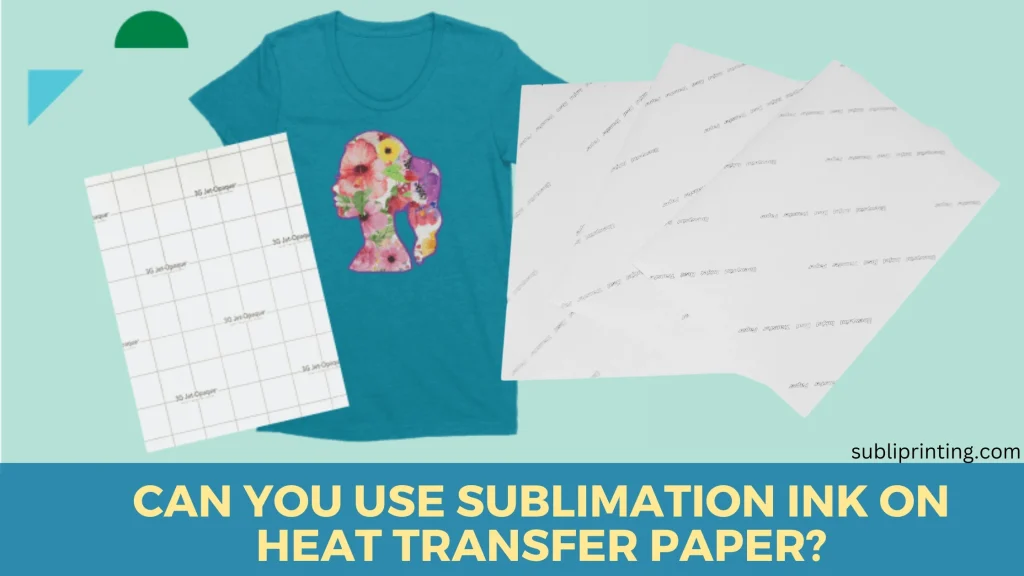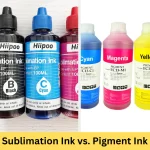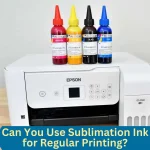Sublimation ink and heat transfer paper are two popular ingredients for creating personalized t-shirts, mugs, hats, or bags with your favorite images, logos, or quotes. But what are they exactly, and can you use them together effectively?
Sublimation ink is a special type of ink that turns from solid to gas without passing through the liquid phase when heated, and bonds with the substrate at a molecular level. Heat transfer paper, on the other hand, is a paper that has a coating of a polymer film that can be printed with an inkjet printer, and transfers the printed image onto a substrate by applying heat and pressure, and peeling off the paper.
You might think that using sublimation ink on heat transfer paper would be a great way to combine the best of both worlds, but you would be wrong. In fact, using sublimation ink on heat transfer paper is one of the biggest mistakes you can make in the printing world, and it will result in poor-quality images that will fade away after a few washes.
Read a detailed comparison between sublimation vs heat transfer.
Contents
- Can You Use Sublimation Ink on Heat Transfer Paper?
- Why Sublimation Ink is Not Compatible with Heat Transfer Paper?
- What Happens When You Use Sublimation Ink on Heat Transfer Paper?
- Does Sublimation Ink Work on Dark Transfer Paper?
- How Long Do Heat Transfer Designs Last on Different Fabrics?
- Factors Affecting Durability
- Pros and Cons of Heat Transfer Printing
- Final Words: Sublimation Ink on Heat Transfer Paper
- Frequently Asked Questions
Can You Use Sublimation Ink on Heat Transfer Paper?
No, it is not recommended to use sublimation ink on heat transfer paper. They are not compatible, and attempting to use them together will not result in a successful transfer.
The reason why sublimation ink is not compatible with heat transfer paper is because they work in different ways. Sublimation ink needs to bond with the substrate, while heat transfer paper creates a barrier between the ink and the substrate.
When you use sublimation ink on heat transfer paper, you are essentially wasting both the ink and the paper, as they are not designed to work together. The ink will not transfer properly because it will be blocked by the paper coating. The result will be a blurry, faded, or distorted image that will not last long.
Read a detailed comparison between sublimation paper vs heat transfer paper.
A common misconception is that you can use sublimation ink on heat transfer paper if you use a sublimation transfer paper instead of a regular heat transfer paper. However, after testing it for a couple of projects, I’ve realized that this paper is only meant to be used with sublimation substrates (polyester items or polyester coated items), not with heat transfer substrates.
If you use sublimation ink and sublimation transfer paper on a heat transfer substrate, such as cotton fabric, you will still end up with a poor-quality image that will not bond with the substrate and will wash off easily.
Also, know the difference between pigment ink vs sublimation ink.
Why Sublimation Ink is Not Compatible with Heat Transfer Paper?
Sublimation ink and heat transfer paper—like two distant cousins at a family reunion. They share some genes (both involve ink and fabric), but their personalities clash. I’m going to reveal the challenges and limitations of sublimation ink with heat transfer paper.
1. Material Preferences
Sublimation Ink: It’s a polyester enthusiast. Give it a polyester canvas, and it’ll create magic. But cotton? Nah, it’s not vibing with cotton.
Heat Transfer Paper: It’s open-minded, accommodating various fabrics. But sublimation ink? It’s like inviting a vegetarian to a steakhouse.
2. Heat Sensitivity
Sublimation ink thrives in the heat, the hotter, the better. But heat transfer paper? It’s like, “Whoa, slow down, ink! I’m not built for this sauna.”
3. Ghosting and Bleeding
When sublimation ink meets heat transfer paper, it might ghost (leave a faint shadow) or bleed (blur edges). And, heat transfer paper is sensitive. Too much ink, and it panics. Too little, and the design looks like a shy whisper.
4. Incorrect Ink-Paper Pairing
Heat transfer paper is specifically designed for use with heat transfer dyes, which have a different chemical composition and compatibility with the paper’s coating. Sublimation ink, on the other hand, is not suited for the release mechanism of heat transfer paper.
As a result, sublimation ink will not release effectively from the heat transfer paper, leading to poor color transfer and incomplete designs.
Here are the best sublimation printers for heat transfer.
What Happens When You Use Sublimation Ink on Heat Transfer Paper?
1. The Vanishing Act
You print your vibrant sublimation design on heat transfer paper and heat press it onto a regular cotton t-shirt. Result? The ink sublimates into the air, leaving the paper bewildered. The t-shirt? Still plain. Magic fail.
Here’s a practical guide to make sublimation prints permanent on fabric.
2. Color Mismatch
Sublimation ink dances in a full-color spectrum. Heat transfer paper? It’s like a grayscale party. Imagine printing a rainbow on paper and expecting it to bloom on a black tee. Nope, the colors won’t sync.
3. Texture Confusion
Sublimation ink wants a smooth ride. Heat transfer paper? It’s got texture—like a bumpy road. The ink stumbles, the paper wrinkles, and the design looks like abstract art gone wrong.
Does Sublimation Ink Work on Dark Transfer Paper?
Unfortunately, NO! Sublimation ink is not designed for any type of transfer paper.
To create personalized designs on dark-colored fabrics, you should use heat transfer dyes and heat transfer paper designed for dark fabrics. Heat transfer ink is formulated to bond to the darker fabric, it creates a surface on top of the fabric to produce vibrant colors.
Attempting to use sublimation ink on dark transfer paper may lead to muted colors, loss of intricate details, and an overall diminished quality of the final print.
Read the guide to make sublimation brighter.
How Long Do Heat Transfer Designs Last on Different Fabrics?
Heat transfer designs, created using materials like heat transfer vinyl (HTV) or iron-on transfers, can have varying lifespans based on fabric type, care, and application. Here’s a breakdown:
1. Cotton Fabrics
Heat transfer designs on cotton fabrics tend to last well. With proper care, they can endure numerous wash cycles. Expect them to remain vibrant for 50 washes if handled correctly.
2. Polyester and Blends
Polyester fabrics are ideal for sublimation printing and heat transfer. Sublimation ink bonds permanently with polyester fibers. Designs on polyester can last for over a year, even with frequent washing.
3. Other Synthetic Fabrics
Fabrics like nylon, spandex, and rayon also work well with heat transfer designs. Their longevity depends on the specific fabric blend and care routine. Generally, you can expect to have 50 careful washes before the prints starts to crack or fade.
Read if you can sublimate on rayon fabric.
4. Specialty Fabrics
Specialty fabrics (such as performance wear, swimwear, or activewear) often contain a blend of synthetic fibers. Prints on these fabrics are durable and can last for many regular washings.
Factors Affecting Durability
- Gentle washing in cold water helps preserve heat transfer designs.
- Turn garments inside out before washing to protect the design.
- Avoid harsh detergents and fabric softeners.
- Air-dry when drying to prevent excessive wear.
- Avoid Prolonged exposure to sunlight, it can fade designs.
- Avoid rubbing the design area vigorously during washing.
- Fold garments instead of hanging them to prevent friction.
Pros and Cons of Heat Transfer Printing
Pros:
- Ease of Use: Heat transfer printing is a relatively simple and straightforward process that doesn’t require specialized equipment or technical expertise.
- Versatility: Heat transfer printing can be used on a wide range of fabrics, including cotton, polyester, nylon, and even blends. This versatility allows for creative freedom and the ability to customize various items, from t-shirts and mugs to tote bags and hats.
- Affordability: It is a relatively cost-effective method for creating personalized items, especially when compared to other printing techniques like screen printing, or sublimation.
Cons:
- Limited Detail: Heat transfer printing may not be suitable for designs with intricate details or fine lines. The transfer process can sometimes blur or soften fine details, making them less defined.
- Not Suitable for High Volumes: While great for small quantities, heat transfer becomes inefficient for large orders. The manual process becomes clumsy when dealing with hundreds or thousands of items.
- Less Durable: Heat transfer printing is less durable, as the image sits on top of the substrate and can crack, peel, or wash off over time, especially if the substrate is exposed to friction, moisture, or heat.
Final Words: Sublimation Ink on Heat Transfer Paper
After looking at the evidences and examples, we’ve concluded that sublimation ink cannot be used on heat transfer paper. Attempting to use sublimation ink on heat transfer paper will result in poor color transfer and less vibrant design.
For successful sublimation printing, it is crucial to use sublimation ink specifically designed for this process, along with sublimation paper or blanks made of polyester or polyester-blend materials.
Frequently Asked Questions
Can I print heat transfer paper with sublimation ink?
For best results, it is not recommended to print heat transfer paper with sublimation ink. If you attempt to do so, your prints on the paper will almost colorless.
Is heat transfer paper the same as sublimation paper?
No, heat transfer paper and sublimation paper are not the same. Heat transfer paper is coated with a special release agent that allows the ink to be transferred onto the fabric using a heat press. Sublimation paper does not have a release agent, and the ink is absorbed into the fabric rather than being transferred onto it.
What ink do you use for heat transfer paper?
For heat transfer paper, you can use standard inkjet printer ink, such as pigment, dye, and solvent-based inks.
- 5 Best 13×19 Sublimation Printer for Wide Format Substrates - December 27, 2023
- Best 11×17 Sublimation Printer to Print Tabloid Size Paper - December 26, 2023
- Epson ET-8550 vs ET-15000: Best Wide-Format EcoTank Printer - December 25, 2023







![What Is Sublimation Ink and How Does It Work? [Read Its Uses] What Is Sublimation Ink](https://subliprinting.com/wp-content/uploads/2022/04/What-is-sublimation-ink-150x150.png)